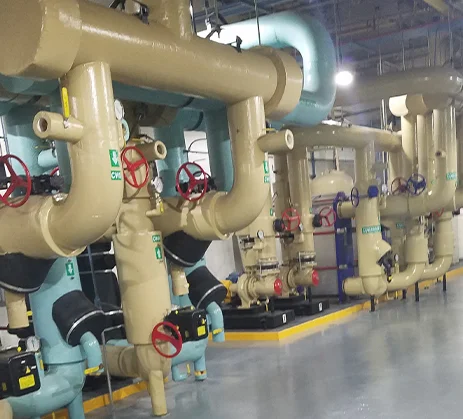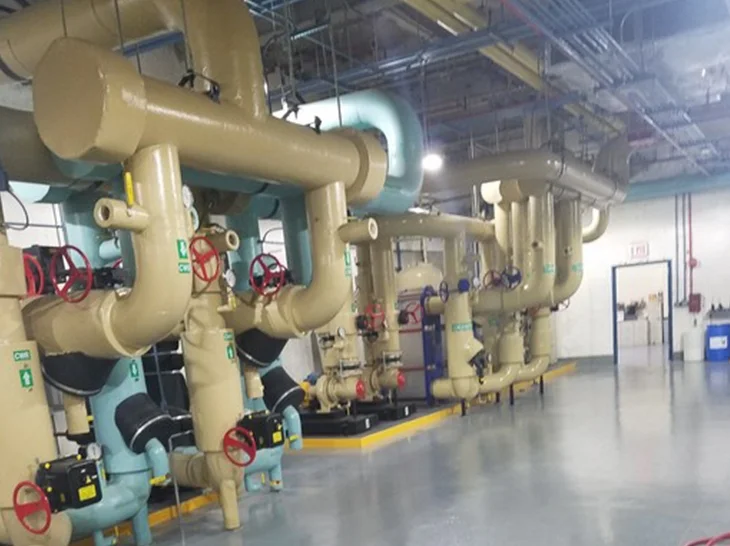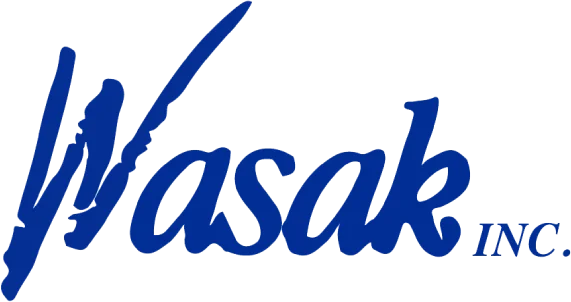
Water Treatment for Industrial Steam Boilers: A Comprehensive Guide
Water treatment is necessary to keep your industrial steam boilers working at their peak. The significance of this process cannot be overstated. It directly influences various aspects of your boiler’s performance and lifespan. Efficient and timely water treatment in a boiler helps boost system efficiency by preventing scale and deposit formation.
Without treatment, your boiler will gather scale and mineral deposits. That, in turn, will affect the heat transfer and reduce the operational efficiency of your boiler system. It is one of the most common boiler problems you will face. Besides, water treatment helps in corrosion prevention. As a plant manager, you may know how persistent a threat corrosion is and how it can compromise the structural integrity of your boiler components.
Fortunately, you can overcome this issue with timely boiler water treatment. Furthermore, water treatment is instrumental in preventing oxygen pitting. It also increases safety and reduces environmental impact. These benefits reduce operating costs and extend the life of your boiler system.
Let’s learn more about water treatment in a boiler.
Key Water Quality Parameters
The first step in boiler water treatment is observing the key water quality parameters. These parameters help you understand the water composition and optimize boiler performance.
These parameters include:
I. Hardness:
Hardness refers to the concentration of minerals in water, primarily calcium and magnesium. Excessive hardness leads to scale formation, which reduces heat transfer efficiency.
II. Alkalinity:
Alkalinity is a measure of water’s capacity to neutralize acids. In boiler systems, controlling alkalinity helps in acidic corrosion prevention. It also helps stabilize the water pH scale. In short, the right alkalinity is vital for safeguarding your system components.
III. pH:
The pH level indicates the acidity or alkalinity of water. Proper pH measurement and control are essential to prevent corrosion and scale formation. Deviating from the optimal pH range can compromise your system components.
IV. Conductivity:
Conductivity is the ability of water to conduct electrical current. It tells you about the overall mineral content of the water. Monitoring specific conductivity is critical for measuring water purity and preventing excessive mineral buildup that can cause equipment damage.
V. Total Dissolved Solids (TDS):
TDS is the total concentration of dissolved substances in water. As you can see, elevated TDS levels can contribute to scale formation and corrosion.
VI. Dissolved Oxygen Content:
Higher dissolved oxygen levels in water can lead to corrosion. Monitoring and controlling dissolved oxygen levels are critical for pitting and corrosion prevention.
Common Boiler Problems Related to Water
Failure to monitor the above parameters can lead to several issues. These common boiler problems usually include:
I. Scale and Deposit Formation:
Scale and deposit formation reduces heat transfer capacity. It can potentially lead to equipment failure and costly repairs. You need to address this issue as soon as possible.
II. Corrosion: :
Corrosion compromises your boiler components. It can also cause leaks and structural damage. Effective corrosion prevention is necessary to prolong the life of your steam boiler.
III. Carryover:
Carryover, the entrainment of water droplets in steam, adversely affects steam quality. It can reduce heat transfer efficiency, damage equipment, and weaken your production processes.
IV. Surging:
Surging, characterized by fluctuating water levels in the boiler, can result in operational instability. Proper water level monitoring is imperative to prevent surging. It ensures consistent steam production and safeguards your equipment.
V. Oxygen Pitting:
Oxygen pitting occurs when dissolved oxygen in water corrodes metal surfaces. This can cause localized damage and weaken your boiler components. Controlling oxygen levels is essential to prevent pitting.
VI. Thermal Shock:
Thermal shock comes with rapid temperature changes. It can cause stress on metal components, leading to cracks and failures.
VII. Excess Water Loss:
Excessive water loss can result from leaks or improper boiler water treatment. As you can imagine, excess water loss can lead to costly repairs.
Water Treatment Methods
Effective water treatment is your only option to keep your steam boilers working smoothly and efficiently. There are two major boiler water treatment options, system considerations and chemical treatment.
Let’s understand both.
1. System Considerations
You will need to think about different system components to ensure smooth boiler operations. Here’s what you can’t miss.
I. Pre-treatment:
Effective pre-treatment techniques are your initial line of defense against water impurities. While softening mitigates the adverse effects of hardness, demineralization reduces mineral content. On the other hand, reverse osmosis removes contaminants. These processes collectively safeguard your steam boiler against scale formation.
II. Chemical Feed Systems:
You need meticulous chemical feed system management. So, you should maintain proper feed rates and select suitable injection locations. It’s the best way to introduce treatment chemicals. This precision is paramount to address specific water quality parameters.
III. Deaeration:
Deaeration is an effective corrosion prevention treatment. You can minimize corrosion risks with sparge lines and deaeration tanks. The process removes dissolved gases, particularly oxygen, from the boiler feedwater. That’s what reduces the risk of corrosion.
IV. Condensate Treatment:
Amines, incorporated into condensate treatment protocols, play a pivotal role in corrosion prevention. This approach safeguards against corrosion. But it also ensures the efficient recycling of high-quality water in your steam system.
V. Blowdown:
There are two steps in this treatment – the first is surface blowdown, and the second is bottom blowdown.
- Surface Blowdown is indispensable to maintain optimal boiler water parameters. It removes sediment, excess chemicals, and solids from the water surface. Surface blowdown also prevents carryover, corrosion, and scaling. In short, this treatment keeps your boiler system clean and efficient.
- Bottom Blowdown involves removing sludge, a byproduct of water treatment and boiler operation. It maintains system integrity and mitigates potential operational challenges. But this is a job best left for a professional. Let your chemical treatment provider determine the frequency and duration of the bottom blowdown.
2. Chemical Treatments
System considerations alone aren’t enough to address common boiler problems. You also need regular preventive chemical treatments to keep your steam boilers spick and span.
Here’s what you need to keep in mind.
I. Main Treatment Programs
Some of the main treatment programs include:
- Phosphate Treatment: Phosphate treatment involves adding phosphates to the boiler water for scale corrosion prevention. This treatment is particularly effective in high-pressure boilers.
- Polymer Treatment: This treatment uses polymer-based chemicals to control sludge and scale formation in the boiler water. These additives improve water purity and prevent the accumulation of impurities on heat transfer surfaces.
- Chelants Treatment: Chelating agents are used to bind with metal ions, preventing scale and corrosion. This treatment is effective for water with high metal content.
- Hybrid Program: It combines elements from different treatment programs. This customization helps you maintain specific water quality parameters.
II. Oxygen Scavengers:
Oxygen scavengers are chemicals designed to remove damaging dissolved oxygen from boiler feedwater. As you can see, this treatment is highly effective in corrosion prevention.
III. Alkalinity Control:
Alkalinity control is critical for maintaining the appropriate pH levels. Proper alkalinity control helps prevent acidic corrosion, increasing the lifespan and performance of your steam boilers.
IV. Steam Line Treatment or Amines:
Amines are commonly used in steam line treatment to protect against corrosion. Choosing the right type of amines depends on your system layout and operation requirements.
- Neutralizing Amines: These amines neutralize acidic conditions in the steam and condensate system, preventing corrosion in pipes and components.
- Passivating Amines: Passivating amines form a protective layer on metal surfaces, inhibiting corrosion and preserving the integrity of your steam system.
- Filming Amines: These amines create a thin protective film on metal surfaces, offering corrosion protection and increasing the life of steam distribution components.
Conclusion
Water treatment plays a vital role in ensuring optimal efficiency, preventing corrosion, and promoting the lifespan of your industrial steam boilers. With environmental sustainability becoming necessary, effective water treatment practices have become even more critical. Plus, these practices also help you prevent costly repairs. Whether system considerations or chemical treatments, maintain the required water level parameters.
Do you need help with boiler water treatment? We are experts in steam boiler water treatment and maintenance. Contact us today to learn more about our cooling tower treatment services.
Related Blog
-

Why Do We Use Chemicals in Steam Boiler Water Treatment?
The steam boilers have become a cornerstone in industries like power generation, manufacturing, and heating. Essentially, it converts water into steam to drive factory machinery,
